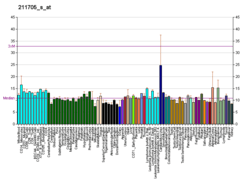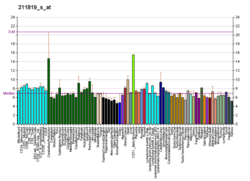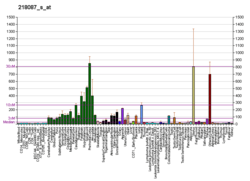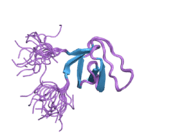SORBS1
CAP/Ponsin protein, also known as Sorbin and SH3 domain-containing protein 1 is a protein that in humans is encoded by the SORBS1 gene.[5][6][7] CAP/Ponsin is part of a small family of adaptor proteins that regulate cell adhesion, growth factor signaling and cytoskeletal formation. CAP/Ponsin is mainly expressed in heart, skeletal muscle, liver, adipose tissue, and macrophages; in striated muscle tissue, CAP/Ponsin is localized to costamere structures.
Structure
CAP/Ponsin may exist as thirteen alternatively-spliced isoforms, ranging from 81 kDa to 142 kDa.[8] CAP/Ponsin is part of an adaptor protein family, of which ArgBP2 and vinexin are also a part.[9] These proteins contain a conserved sorbin homology (SOHO) domain and three SH3 domains, and CAP/Ponsin is expressed in heart, skeletal muscle, liver, adipose tissue, and macrophages.[8][10][11]
Function
In muscle, CAP/Ponsin plays a role in the formation of mature costameres from focal adhesion-like contacts during assembly of the contractile apparatus, as overexpression of CAP/Ponsin disrupted normal cell-matrix contact morphology.[12] In a mouse model of viral myocarditis due to Coxsackievirus infection, CAP/Ponsin stabilized antiviral type I interferon production and was protective against apoptosis and cytotoxicity.[13] CAP/Ponsin has also been shown to be a major regulator of insulin-stimulated signaling and regulation of glucose uptake, by potentiating insulin-induced phosphorylation and recruitment of CBL to a lipid raft signaling complex involving flotillin.[14] A role for CAP/Ponsin in macrophage function was illuminated by the finding that mice harboring SORBS1-deficient macrophages in bone marrow was protective against high-fat diet-induced insulin resistance and showed reduced inflammation.[11] In non-muscle cells, CAP/Ponsin inhibits cell spreading and focal adhesion turnover, as its siRNA-mediated knockdown resulted in enhanced PAK/MEK/ERK activation and cell migration.[15]
Clinical Significance
CAP/Ponsin was demonstrated to be down-regulated in end-stage heart failure patients; an effect that was restored upon mechanical unloading.[12] A single nucleotide polymorphism in SORBS1 was found to be associated with type 2 diabetes and obesity.[16]
Interactions
SORBS1 has been shown to interact with:
References
- GRCh38: Ensembl release 89: ENSG00000095637 - Ensembl, May 2017
- GRCm38: Ensembl release 89: ENSMUSG00000025006 - Ensembl, May 2017
- "Human PubMed Reference:". National Center for Biotechnology Information, U.S. National Library of Medicine.
- "Mouse PubMed Reference:". National Center for Biotechnology Information, U.S. National Library of Medicine.
- Mandai K, Nakanishi H, Satoh A, Takahashi K, Satoh K, Nishioka H, Mizoguchi A, Takai Y (Mar 1999). "Ponsin/SH3P12: an l-afadin- and vinculin-binding protein localized at cell-cell and cell-matrix adherens junctions". The Journal of Cell Biology. 144 (5): 1001–17. doi:10.1083/jcb.144.5.1001. PMC 2148189. PMID 10085297.
- Baumann CA, Ribon V, Kanzaki M, Thurmond DC, Mora S, Shigematsu S, Bickel PE, Pessin JE, Saltiel AR (Sep 2000). "CAP defines a second signalling pathway required for insulin-stimulated glucose transport" (PDF). Nature. 407 (6801): 202–7. doi:10.1038/35025089. hdl:2027.42/62940. PMID 11001060.
- "Entrez Gene: SORBS1 sorbin and SH3 domain containing 1".
- Lin WH, Huang CJ, Liu MW, Chang HM, Chen YJ, Tai TY, Chuang LM (May 2001). "Cloning, mapping, and characterization of the human sorbin and SH3 domain containing 1 (SORBS1) gene: a protein associated with c-Abl during insulin signaling in the hepatoma cell line Hep3B". Genomics. 74 (1): 12–20. doi:10.1006/geno.2001.6541. PMID 11374898.
- Kioka N, Ueda K, Amachi T (Feb 2002). "Vinexin, CAP/ponsin, ArgBP2: a novel adaptor protein family regulating cytoskeletal organization and signal transduction". Cell Struct Funct. 27: 1–7. doi:10.1247/csf.27.1. PMID 11937713.
- Ribon V, Printen JA, Hoffman NG, Kay BK, Saltiel AR (Feb 1998). "A novel, multifuntional c-Cbl binding protein in insulin receptor signaling in 3T3-L1 adipocytes". Molecular and Cellular Biology. 18 (2): 872–9. doi:10.1128/mcb.18.2.872. PMC 108798. PMID 9447983.
- Lesniewski LA, Hosch SE, Neels JG, de Luca C, Pashmforoush M, Lumeng CN, Chiang SH, Scadeng M, Saltiel AR, Olefsky JM (Apr 2007). "Bone marrow-specific Cap gene deletion protects against high-fat diet-induced insulin resistance". Nature Medicine. 13 (4): 455–62. doi:10.1038/nm1550. PMID 17351624.
- Gehmlich K, Pinotsis N, Hayess K, van der Ven PF, Milting H, El Banayosy A, Körfer R, Wilmanns M, Ehler E, Fürst DO (Jun 2007). "Paxillin and ponsin interact in nascent costameres of muscle cells". Journal of Molecular Biology. 369 (3): 665–82. doi:10.1016/j.jmb.2007.03.050. PMID 17462669.
- Valaperti A, Nishii M, Liu Y, Yang H, Naito K, Liu PP, Eriksson U (May 2014). "The adapter protein c-Cbl-associated protein (CAP) protects from acute CVB3-mediated myocarditis through stabilization of type I interferon production and reduced cytotoxicity" (PDF). Basic Research in Cardiology. 109 (3): 411. doi:10.1007/s00395-014-0411-3. PMID 24763933.
- Baumann CA, Ribon V, Kanzaki M, Thurmond DC, Mora S, Shigematsu S, Bickel PE, Pessin JE, Saltiel AR (Sep 2000). "CAP defines a second signalling pathway required for insulin-stimulated glucose transport" (PDF). Nature. 407 (6801): 202–7. doi:10.1038/35025089. hdl:2027.42/62940. PMID 11001060.
- Zhang M, Liu J, Cheng A, Deyoung SM, Chen X, Dold LH, Saltiel AR (Nov 2006). "CAP interacts with cytoskeletal proteins and regulates adhesion-mediated ERK activation and motility". The EMBO Journal. 25 (22): 5284–93. doi:10.1038/sj.emboj.7601406. PMC 1636617. PMID 17082770.
- Lin WH, Chiu KC, Chang HM, Lee KC, Tai TY, Chuang LM (Aug 2001). "Molecular scanning of the human sorbin and SH3-domain-containing-1 (SORBS1) gene: positive association of the T228A polymorphism with obesity and type 2 diabetes". Human Molecular Genetics. 10 (17): 1753–60. doi:10.1093/hmg/10.17.1753. PMID 11532984.
- Haglund K, Ivankovic-Dikic I, Shimokawa N, Kruh GD, Dikic I (May 2004). "Recruitment of Pyk2 and Cbl to lipid rafts mediates signals important for actin reorganization in growing neurites". Journal of Cell Science. 117 (Pt 12): 2557–68. doi:10.1242/jcs.01148. PMID 15128873.
- Vandenbroere I, Paternotte N, Dumont JE, Erneux C, Pirson I (Jan 2003). "The c-Cbl-associated protein and c-Cbl are two new partners of the SH2-containing inositol polyphosphate 5-phosphatase SHIP2". Biochemical and Biophysical Research Communications. 300 (2): 494–500. doi:10.1016/s0006-291x(02)02894-2. PMID 12504111.
- Kimura A, Baumann CA, Chiang SH, Saltiel AR (Jul 2001). "The sorbin homology domain: a motif for the targeting of proteins to lipid rafts". Proceedings of the National Academy of Sciences of the United States of America. 98 (16): 9098–103. doi:10.1073/pnas.151252898. PMC 55379. PMID 11481476.
- Xie J, Cai T, Zhang H, Lan MS, Notkins AL (Jul 2002). "The zinc-finger transcription factor INSM1 is expressed during embryo development and interacts with the Cbl-associated protein". Genomics. 80 (1): 54–61. doi:10.1006/geno.2002.6800. PMC 1237014. PMID 12079283.
Further reading
- Kioka N (Nov 2002). "[A novel adaptor protein family regulating cytoskeletal organization and signal transduction--Vinexin, CAP/ponsin, ArgBP2]". Seikagaku. The Journal of Japanese Biochemical Society. 74 (11): 1356–60. PMID 12510380.
- Ribon V, Herrera R, Kay BK, Saltiel AR (Feb 1998). "A role for CAP, a novel, multifunctional Src homology 3 domain-containing protein in formation of actin stress fibers and focal adhesions". The Journal of Biological Chemistry. 273 (7): 4073–80. doi:10.1074/jbc.273.7.4073. PMID 9461600.
- Asakura T, Nakanishi H, Sakisaka T, Takahashi K, Mandai K, Nishimura M, Sasaki T, Takai Y (Oct 1999). "Similar and differential behaviour between the nectin-afadin-ponsin and cadherin-catenin systems during the formation and disruption of the polarized junctional alignment in epithelial cells". Genes to Cells. 4 (10): 573–81. doi:10.1046/j.1365-2443.1999.00283.x. PMID 10583506.
- Nagase T, Kikuno R, Ishikawa KI, Hirosawa M, Ohara O (Feb 2000). "Prediction of the coding sequences of unidentified human genes. XVI. The complete sequences of 150 new cDNA clones from brain which code for large proteins in vitro". DNA Research. 7 (1): 65–73. doi:10.1093/dnares/7.1.65. PMID 10718198.
- Hartley JL, Temple GF, Brasch MA (Nov 2000). "DNA cloning using in vitro site-specific recombination". Genome Research. 10 (11): 1788–95. doi:10.1101/gr.143000. PMC 310948. PMID 11076863.
- Lebre AS, Jamot L, Takahashi J, Spassky N, Leprince C, Ravisé N, Zander C, Fujigasaki H, Kussel-Andermann P, Duyckaerts C, Camonis JH, Brice A (May 2001). "Ataxin-7 interacts with a Cbl-associated protein that it recruits into neuronal intranuclear inclusions". Human Molecular Genetics. 10 (11): 1201–13. doi:10.1093/hmg/10.11.1201. PMID 11371513.
- Lin WH, Huang CJ, Liu MW, Chang HM, Chen YJ, Tai TY, Chuang LM (May 2001). "Cloning, mapping, and characterization of the human sorbin and SH3 domain containing 1 (SORBS1) gene: a protein associated with c-Abl during insulin signaling in the hepatoma cell line Hep3B". Genomics. 74 (1): 12–20. doi:10.1006/geno.2001.6541. PMID 11374898.
- Kimura A, Baumann CA, Chiang SH, Saltiel AR (Jul 2001). "The sorbin homology domain: a motif for the targeting of proteins to lipid rafts". Proceedings of the National Academy of Sciences of the United States of America. 98 (16): 9098–103. doi:10.1073/pnas.151252898. PMC 55379. PMID 11481476.
- Lin WH, Chiu KC, Chang HM, Lee KC, Tai TY, Chuang LM (Aug 2001). "Molecular scanning of the human sorbin and SH3-domain-containing-1 (SORBS1) gene: positive association of the T228A polymorphism with obesity and type 2 diabetes". Human Molecular Genetics. 10 (17): 1753–60. doi:10.1093/hmg/10.17.1753. PMID 11532984.
- Cowan CA, Henkemeyer M (Sep 2001). "The SH2/SH3 adaptor Grb4 transduces B-ephrin reverse signals". Nature. 413 (6852): 174–9. doi:10.1038/35093123. PMID 11557983.
- Liu J, Kimura A, Baumann CA, Saltiel AR (Jun 2002). "APS facilitates c-Cbl tyrosine phosphorylation and GLUT4 translocation in response to insulin in 3T3-L1 adipocytes". Molecular and Cellular Biology. 22 (11): 3599–609. doi:10.1128/MCB.22.11.3599-3609.2002. PMC 133825. PMID 11997497.
- Xie J, Cai T, Zhang H, Lan MS, Notkins AL (Jul 2002). "The zinc-finger transcription factor INSM1 is expressed during embryo development and interacts with the Cbl-associated protein". Genomics. 80 (1): 54–61. doi:10.1006/geno.2002.6800. PMC 1237014. PMID 12079283.
- Nakayama M, Kikuno R, Ohara O (Nov 2002). "Protein-protein interactions between large proteins: two-hybrid screening using a functionally classified library composed of long cDNAs". Genome Research. 12 (11): 1773–84. doi:10.1101/gr.406902. PMC 187542. PMID 12421765.
- Vandenbroere I, Paternotte N, Dumont JE, Erneux C, Pirson I (Jan 2003). "The c-Cbl-associated protein and c-Cbl are two new partners of the SH2-containing inositol polyphosphate 5-phosphatase SHIP2". Biochemical and Biophysical Research Communications. 300 (2): 494–500. doi:10.1016/S0006-291X(02)02894-2. PMID 12504111.
- Yang WS, Lee WJ, Huang KC, Lee KC, Chao CL, Chen CL, Tai TY, Chuang LM (Apr 2003). "mRNA levels of the insulin-signaling molecule SORBS1 in the adipose depots of nondiabetic women". Obesity Research. 11 (4): 586–90. doi:10.1038/oby.2003.82. PMID 12690089.








